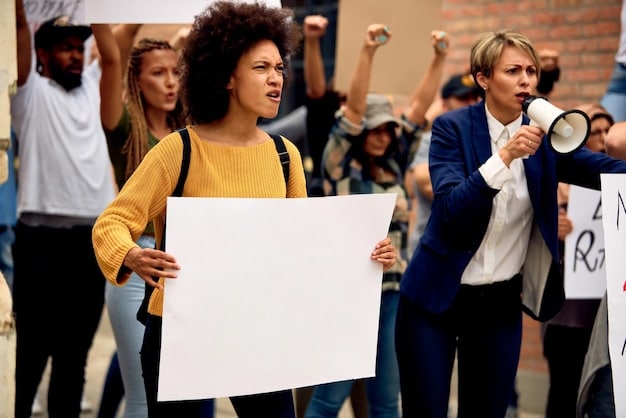Debating Police Reform: Is Excessive Force Down by 10%?

Debating the effectiveness of current police reform policies is crucial to assess whether these measures are truly reducing excessive force incidents by 10%, prompting a closer examination of data, community impact, and sustained accountability.
The conversation around police reform has intensified in recent years, fueled by public outcry and demands for accountability. A central question looms large: Debating the effectiveness of current police reform policies: Are we seeing a 10% reduction in excessive force incidents? This article delves into this issue, examining the data, the debates, and the real-world impact of these reforms.
Understanding the Scope of Police Reform Policies
Police reform encompasses a wide range of initiatives aimed at improving police conduct, increasing transparency, and building trust between law enforcement and the communities they serve. These policies can vary significantly in scope and focus, depending on the specific needs and priorities of different jurisdictions.
Key Areas of Police Reform
Several key areas are commonly addressed in police reform policies. Understanding these areas is essential to evaluating the overall effectiveness of reform efforts.
- Use of Force Policies: These policies dictate when and how officers are allowed to use force, emphasizing de-escalation tactics and proportionality.
- Body-Worn Cameras: The implementation of body-worn cameras aims to enhance transparency and accountability by recording interactions between officers and the public.
- Training and Education: Enhanced training programs focus on implicit bias, cultural sensitivity, and crisis intervention to improve officer decision-making and community relations.
- Community Policing: This approach involves officers working closely with community members to address local concerns and build trust through proactive engagement.
The implementation challenges vary widely across different police departments. Resource constraints, resistance to change from within law enforcement, and lack of community buy-in can all hinder the successful implementation of these policies.

Analyzing Data on Excessive Force Incidents
Measuring the effectiveness of police reform requires careful analysis of data on excessive force incidents. However, obtaining accurate and reliable data can be challenging due to inconsistencies in reporting practices and definitions of excessive force.
Challenges in Data Collection and Interpretation
Interpreting data on police use of force requires an understanding of its limitations. Definitions of “excessive force” can vary, leading to inconsistencies in reporting. Additionally, data collection may be incomplete or biased, particularly in jurisdictions where oversight is weak.
- Data Accuracy and Consistency: The accuracy and consistency of data collection are critical for meaningful analysis. Inconsistent reporting practices and varying definitions of excessive force can skew results.
- Underreporting and Bias: Underreporting of incidents and potential biases in data collection can further complicate the analysis. Addressing these issues is essential for an accurate assessment.
- Comparative Analysis: Comparing data across different jurisdictions requires careful consideration of local contexts. Factors such as population density, crime rates, and community demographics can influence use-of-force incidents.
Despite these challenges, analyzing available data is still essential to assess whether police reform policies are having the desired impact. Trends in use-of-force incidents, citizen complaints, and officer discipline can provide valuable insights.
Careful analysis of available data is essential to determine whether reform policies are leading to a measurable reduction in excessive force. It’s about going beyond anecdotal evidence to see concrete changes.
Examining the Role of Body-Worn Cameras
Body-worn cameras (BWCs) have become a central feature of police reform efforts, with the aim of increasing transparency and accountability. However, the effectiveness of BWCs in reducing excessive force incidents is a subject of ongoing debate.
Benefits of Body-Worn Cameras
Body-worn cameras have several potential benefits, including improved transparency, enhanced accountability, and the ability to gather evidence. When implemented properly, BWCs can foster greater trust between law enforcement and the community.
Studies on effect of body worn cameras are critical to have transparency.
Limitations and Challenges
Despite their potential benefits, BWCs also have limitations and challenges. Privacy concerns, cost considerations, and policy implementation issues can all affect the effectiveness of BWCs.
- Privacy Concerns: The use of BWCs raises privacy concerns, particularly regarding the storage and use of recorded footage. Clear policies are needed to protect individual privacy rights.
- Cost Considerations: The costs associated with purchasing, maintaining, and storing BWC footage can be substantial. Funding challenges may limit the widespread adoption of BWCs.
- Policy Implementation Issues: Effective implementation of BWC policies requires clear guidelines on when cameras should be activated, how footage should be reviewed, and who should have access to the footage.
Understanding the current implementation of BWCs, including compliance and best practice, needs to be addressed to improve transparency.

Evaluating Training and Education Programs
Training and education programs play a vital role in shaping police culture and improving officer conduct. Effective training can help officers develop the skills and knowledge they need to handle difficult situations with professionalism and restraint.
The Importance of Comprehensive Training
Comprehensive training programs that cover a wide range of topics, including implicit bias, de-escalation techniques, and crisis intervention, are crucial for improving officer decision-making and community relations. Ongoing training and professional development can encourage a culture of continuous improvement within law enforcement agencies.
Challenges in Training Implementation
Despite the importance of training, challenges can arise in the design and implementation of effective programs. Limited resources, resistance from officers, and a lack of qualified instructors can all hinder the effectiveness of training efforts.
Looking at current statistics will help give a clear understanding of its effect on resolving escalations. Statistics provide measurable data.
Assessing the Impact of Community Policing
Community policing strategies aim to foster collaboration and trust between law enforcement and the communities they serve. This approach involves officers working closely with residents to address local concerns, solve problems, and build positive relationships.
Benefits of Community Policing
When implemented effectively, community policing can lead to reduced crime rates, improved community relations, and increased trust in law enforcement. Proactive engagement with residents can help officers identify and address the root causes of crime.
- Reduced Crime Rates: Community policing can lead to lower crime rates by addressing the underlying causes of crime and fostering collaboration between law enforcement and the community.
- Improved Community Relations: By building positive relationships with residents, community policing can enhance trust and reduce tensions between law enforcement and the community.
- Increased Trust: When officers are seen as partners in the community, residents are more likely to cooperate with law enforcement and report crimes.
Community involvement and engagement needs to be supported.
The Role of Policy and Oversight
Robust policies and effective oversight mechanisms are essential for sustaining police reform efforts. Clear policies provide guidance on expected officer conduct, while oversight bodies ensure accountability and transparency.
Policy Development
Developing effective policies requires input from a wide range of stakeholders, including law enforcement, community members, and legal experts. Policies should be clear, concise, and consistent with legal standards.
Oversight Mechanisms
Independent oversight bodies can play a crucial role in ensuring accountability and transparency in law enforcement. These bodies can investigate complaints, review policies, and make recommendations for improvement.
- Investigating Complaints: Independent oversight bodies can investigate complaints of misconduct, ensuring that allegations are thoroughly and impartially examined.
- Reviewing Policies: Oversight bodies can review police policies to ensure they are consistent with legal standards and best practices.
- Making Recommendations: Based on their findings, oversight bodies can make recommendations for policy changes, training improvements, and disciplinary actions.
Effective policies and strong oversight are essential for holding officers accountable and promoting a culture of professionalism within law enforcement agencies. Sustained accountability is crucial.
| Key Point | Brief Description |
|---|---|
| 🚨 Data Analysis | Analyzing excessive force incidents to measure policy effectiveness. |
| 📹 Body Cameras | Using body-worn cameras to enhance transparency and accountability. |
| 🤝 Community Policing | Fostering collaboration between law enforcement and the community. |
| 📚 Training | Improving officer conduct through comprehensive training programs. |
FAQ
▼
Police reform policies primarily aim to reduce police misconduct, increase transparency, enhance accountability, and build trust between law enforcement and the communities they serve.
▼
Body-worn cameras enhance transparency by recording interactions between officers and the public, providing an objective record that can be used to investigate complaints and promote accountability.
▼
Community policing fosters collaboration and trust between police and residents. Officers work with community members to address local concerns, solve problems, and build positive relationships.
▼
Data analysis helps determine the effectiveness of reform policies by tracking trends in excessive force incidents, citizen complaints, and officer discipline, providing insights for improvement.
▼
Oversight bodies investigate complaints, review policies, and make recommendations to improve police accountability and transparency, ensuring that misconduct is addressed and policies are fair.
Conclusion
Debating the effectiveness of current police reform policies is a nuanced process that requires a comprehensive understanding of data analysis, community policing, officer and oversight accountability. While some studies suggest a reduction in excessive force incidents attributable to reform efforts, the overall picture remains complex. Sustained and continuous commitment to these polices is critical to truly and effectively impacting reduction of excessive force incidents.





